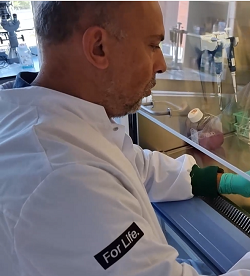Novel gene therapies for hereditary anemia
NewsSanquin, in collaboration with the Hubrecht Institute, has developed several innovative gene therapies for sickle cell disease and beta-thalassemia. These inherited conditions result in severe anemia and other serious, life-threatening complications, affecting approximately 2,000 patients in the Netherlands. The work will soon be published in Blood.
 In these disorders, a DNA mutation disrupts the proper formation of the hemoglobin (Hb) protein, leading to various issues in red blood cells. For instance, their ability to bind and release oxygen is impaired. The new gene therapies aim to induce the production of a different form of hemoglobin, fetal Hb, which is typically present only during fetal development.
In these disorders, a DNA mutation disrupts the proper formation of the hemoglobin (Hb) protein, leading to various issues in red blood cells. For instance, their ability to bind and release oxygen is impaired. The new gene therapies aim to induce the production of a different form of hemoglobin, fetal Hb, which is typically present only during fetal development.
Dr. Emile van den Akker's research group employs CRISPR-Cas9, a gene-editing tool, to remove a specific DNA segment from patients' blood stem cells in the laboratory. This manipulation triggers the production of fetal Hb and suppresses the faulty gene. Sanquin is conducting this research in partnership with the Hubrecht Institute, the Oncode Institute, Amsterdam UMC, and Erasmus MC. Currently, patients rely on donor stem cells for treatment; however, a suitable donor is not always available, and donor stem cells often cause significant side effects. Therefore, the ability to treat patients with their own modified stem cells offers substantial advantages.
Fetal Hemoglobin
During pregnancy, the fetus obtains oxygen from the mother's blood via the placenta. Fetal Hb has a stronger affinity for oxygen than adult Hb, enabling the baby's red blood cells to readily acquire oxygen released from the mother's blood cells. In the first year after birth, infants transition to adult Hb, which facilitates the release of oxygen to the tissues.
However, according to van den Akker, fetal Hb is not unsuitable for life outside the womb. "In cases of hereditary persistence of fetal hemoglobin (HPFH), the switch to adult Hb is incomplete, and individuals continue to produce fetal Hb throughout their lives. Remarkably, people with HPFH who also carry a mutation that would typically cause sickle cell disease or Beta-thalassemia only experience mild symptoms. This indicates that fetal Hb is a viable alternative for patients with these conditions. We are further developing these techniques into a patient treatment in collaboration with Sanquin's Laboratory for Cell Therapy and our partners, who possess extensive expertise in processing and storing stem cells."
A British company has previously developed a similar gene therapy using a different approach, with a treatment cost of approximately 2.5 million euros per patient. Negotiations regarding its reimbursement in the Netherlands are ongoing.
As a non-profit institute, Sanquin is committed to developing therapies sustainably to ensure they are affordable for the intended patient population.
Looking ahead, van den Akker hopes that Sanquin can develop a therapy where stem cells are genetically modified directly within the patient's body, rather than in the lab. This would be less burdensome, as it would eliminate the need for patients to undergo chemotherapy before receiving their modified stem cells.
